Evaluation of load distribution in removal operations: a comparison of techniques and equipment
Evaluation of load distribution in removal operations: a comparison of techniques and equipment
Matt Follett, Université du Québec à Montréal (UQAM)
Recent advances in rigging hardware (rigging rings and rigging thimbles) have altered the way arborists perceive how loads are distributed through the rigging system and tree crown; however, little empirical research has been presented on the effects of these systems in practical use. Traditional rigging hardware has utilized a block (rotating sheave) at the upper anchor point in the rigging system; while these devices are efficient at transferring the load through the line, they cause a multiplication effect to the anchor point. This inherent feature comes as a flaw when rigging, as the load the anchor point must bear is often close to 2 times that of the actual suspended load.
Previous to these current rigging systems, ropes were run through natural branch unions, this caused a friction point which dissipated the load and minimized the forces exerted on the rigging point. However this system is inherently hard on the ropes used, and the tree if it is to be retained (damaged cambium layer), furthermore arborists found it difficult to anticipate the required energy to deaccelerate the falling load.
With the intent to replicate the natural branch union friction point, while still maintaining the repeatability, arborists started to use rigging rings and thimbles, where the upper anchor point is no longer a rotating sheave, but a stationary ring that provides for adequate rope bend radius, and some energy dispersal in the form of heat. While these systems have quickly become popular among climbing and rigging arborists (most reporting improved feel in the tree, and improved “safety”) and several manufactures are introducing products, there has been little empirical research presented. Furthermore, little – if any – have tested the products in a situation where the load is allowed to “run”. Rather the load has been stopped abruptly (“snubbed off”) and the impact loads compared against other rigging anchor apparatus tested in the same fashion.
In this project we would set out to compare a variety of rigging anchor points in an experimental fashion with a repeatable and consistent method of deaccelerating the falling load (“letting it run”), as is recommended by manufactures and the industry as a whole. This would provide results useable for the rigging industry, with regard to increasing safety and understanding of the loads encountered when utilizing these new systems. The results from this project would be disseminated through a scientific journal, industry magazine, and verbal/practical workshop environments.
Study Results:
The force measured at the portawrap is shown in Figure 6, all rings routinely saw approximately ½ the load compared to the block. The initial strain on the stem can be seen in Figure 7, note there is an approximate 1/3 reduction in measured stem stress for the 3 stationary anchors as compared to the rotating block. A proxy for the load on the upper anchor point (calculated through rope tension and accelerometer dat a) shows a decrease in anchor load (Figure8), which maps nicely with the decrease in stem strain. If we isolate the calculated load from the accelerometer we have what can be considered the load in the lead rope, and here we do not see such a decrease(Figure 9). This of course makes sense, as we still have the same potential energy to dissipate, and the only way to realize a deviation in this result would be from a change in the time to slow the falling piece once on rope.
In sum, it would appear that in a running rope scenario, the use of rigging rings will reduce strain on the stem; however they may not reduce the load on the attachment point at the falling piece.
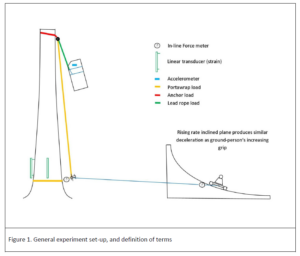
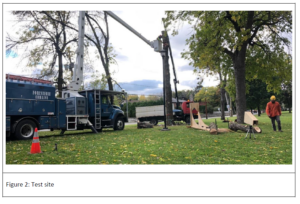
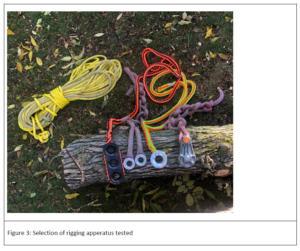
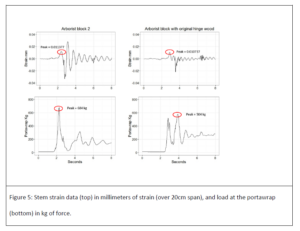
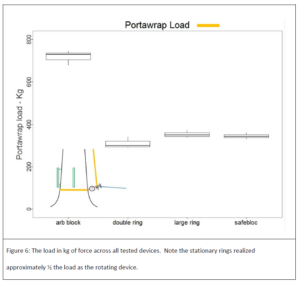
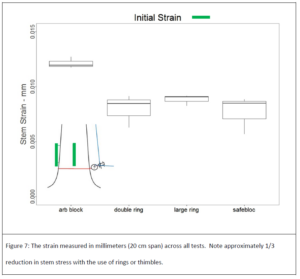
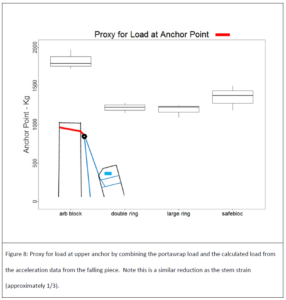
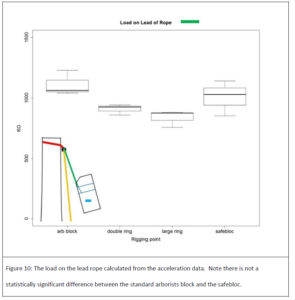
Year of Grant Awarded: 2019
Grant Program: Safe Arborists Technique Fund Grant Program
Grant Title: Evaluation of load distribution in removal operations: a comparison of techniques and equipment
Researcher: Matt Follett
